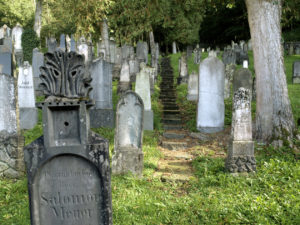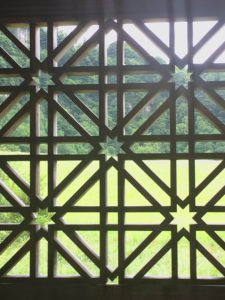Like the town’s Jewish community, the Jewish Cemetery in Hohenems will turn 400 next year. When the town’s imperial count issued a Letter of Protection for twelve Jewish families in 1617, he also granted them a plot of land for use as a cemetery. It’s located on the Schwefelberg, or sulphur hill, a little bit outside the main part of town.
National-Socialist authorities confiscated the cemetery in 1938, but it remarkably survived the war with relatively little damage. Since there was no longer a Jewish community in Hohenems after 1945, the cemetery was restituted to the Jewish community of Innsbruck,¹ from whom it was later bought by a group of Hohenems descendants living in Switzerland. They founded an association which still manages the cemetery today.

Today, there may be over 500 people buried in the Jewish cemetery, although only 370 headstones are visible. Several of my ancestors are among those interred. To help visitors navigate the cemetery, the museum offers a database with the names, inscriptions, and grave numbers here. (It is in German). Additionally, pictures of a majority of the gravestones are available here with connections to information from the Hohenems genealogy database, thanks to ongoing work in the museum’s archives.²
According to Jewish tradition, graves are forever. A grave site can only be allocated once; that plot of land belongs to the person who died. In this way, Jewish graves create a permanent connection to place—regardless of the size of the Jewish community of Hohenems or the presence of the diaspora, the cemetery is a permanent reminder of the Jewish claim to, and influence in, Hohenems.
Like a lot of things in Hohenems, the Jewish cemetery is currently under construction. The work should be finished by next summer.

As the Jewish cemetery celebrates its 400th birthday next summer, the area’s Islamic cemetery will hit its own milestone—it turns five years old, having opened in 2012.
The Islamic cemetery is officially under the jurisdiction of the town of Altach, although geographically it lies just off the road between Hohenems and Götzis, while Altach is slightly to the northwest. The drive between the Jewish and Islamic cemeteries takes only a few minutes.
The Islamic cemetery’s prayer room was designed by Azra Akšamija, a Bosnian-born Muslim architect who currently teaches at the Massachusetts Institute of Technology (MIT), in the United States. She and Austrian architect Bernardo Bader were awarded the Aga Khan Award for Architecture for the cemetery in 2013.

While the Jewish cemetery in Hohenems remembers a population whose time seems to have passed, the Islamic cemetery represents a community that is still in formation. Previously, many of Vorarlberg’s Muslim residents sent their remains home (usually to Turkey) for burial so that their final resting place was with their family. Now, whole families have laid their roots in Austria.
Populations are rarely permanent, but gravestones usually are. Regardless of religious faith, cemeteries serve as a reminder of historical heritage and of places that once felt like home. And there’s something beautiful about that.
¹ Geography Lesson: Innsbruck is the capital city of Tyrol, the Austrian state directly east of Vorarlberg. It is about two hours from Hohenems.
² This post was updated at 10:41 on 21/06/2016 to include this point. The new gravestone pictures are still a work in progress.


thank you for staying in contact with us.